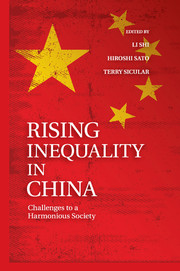Book contents
- Frontmatter
- Contents
- List of Tables
- List of Figures
- Contributors
- Preface
- Abbreviations
- Glossary
- 1 Rising Inequality in China
- 2 Overview
- 3 Housing Ownership, Incomes, and Inequality in China, 2002–2007
- 4 Educational Inequality in China
- 5 Inequality and Poverty in Rural China
- 6 The Evolution of the Migrant Labor Market in China, 2002–2007
- 7 A New Episode of Increased Urban Income Inequality in China
- 8 Unemployment and the Rising Number of Nonworkers in Urban China
- 9 Do Employees in the Public Sector Still Enjoy Earnings Advantages?
- 10 Redistributive Impacts of the Personal Income Tax in Urban China
- 11 Changes in the Gender-Wage Gap in Urban China, 1995–2007
- 12 Intertemporal Changes in Ethnic Urban Earnings Disparities in China
- Appendix I The 2007 Household Surveys
- Appendix II The 2002 and 2007 CHIP Surveys
- Index
- References
Appendix I - The 2007 Household Surveys
Sampling Methods and Data Description
Published online by Cambridge University Press: 05 July 2013
- Frontmatter
- Contents
- List of Tables
- List of Figures
- Contributors
- Preface
- Abbreviations
- Glossary
- 1 Rising Inequality in China
- 2 Overview
- 3 Housing Ownership, Incomes, and Inequality in China, 2002–2007
- 4 Educational Inequality in China
- 5 Inequality and Poverty in Rural China
- 6 The Evolution of the Migrant Labor Market in China, 2002–2007
- 7 A New Episode of Increased Urban Income Inequality in China
- 8 Unemployment and the Rising Number of Nonworkers in Urban China
- 9 Do Employees in the Public Sector Still Enjoy Earnings Advantages?
- 10 Redistributive Impacts of the Personal Income Tax in Urban China
- 11 Changes in the Gender-Wage Gap in Urban China, 1995–2007
- 12 Intertemporal Changes in Ethnic Urban Earnings Disparities in China
- Appendix I The 2007 Household Surveys
- Appendix II The 2002 and 2007 CHIP Surveys
- Index
- References
Summary
To track the dynamics of income distribution in China, the Chinese Household Income Project (CHIP) has conducted four waves of household surveys, in 1988, 1995, 2002, and lastly 2007. These surveys were carried out as part of a collaborative research project on incomes and inequality in China organized by Chinese and international researchers, with assistance from the National Bureau of Statistics (NBS). The CHIP project participants and other researchers have analyzed the data from the first three waves and published a wide range of articles, reports, and books. Descriptions of the CHIP surveys and key findings can be found in Griffin and Zhao (1993); Riskin, Zhao, and Li (2001); and Gustafsson, Li, and Sicular (2008). This volume not only contains analyses based on the data from the fourth wave, 2007 but also uses data from the earlier waves to understand trends over time.
Eichen and Zhang (1993) describe the 1988 survey, and Li et al. (2008) describe the 1995 and 2002 surveys. This Appendix provides basic information about the 2007 survey. The CHIP surveys are closely related to the NBS household survey. Li et al. (2008) discuss how the NBS household survey samples were selected. Additional details about the NBS household surveys can be found in recent NBS statistical reports and publications.
- Type
- Chapter
- Information
- Rising Inequality in ChinaChallenges to a Harmonious Society, pp. 445 - 464Publisher: Cambridge University PressPrint publication year: 2013
References
- 2
- Cited by



